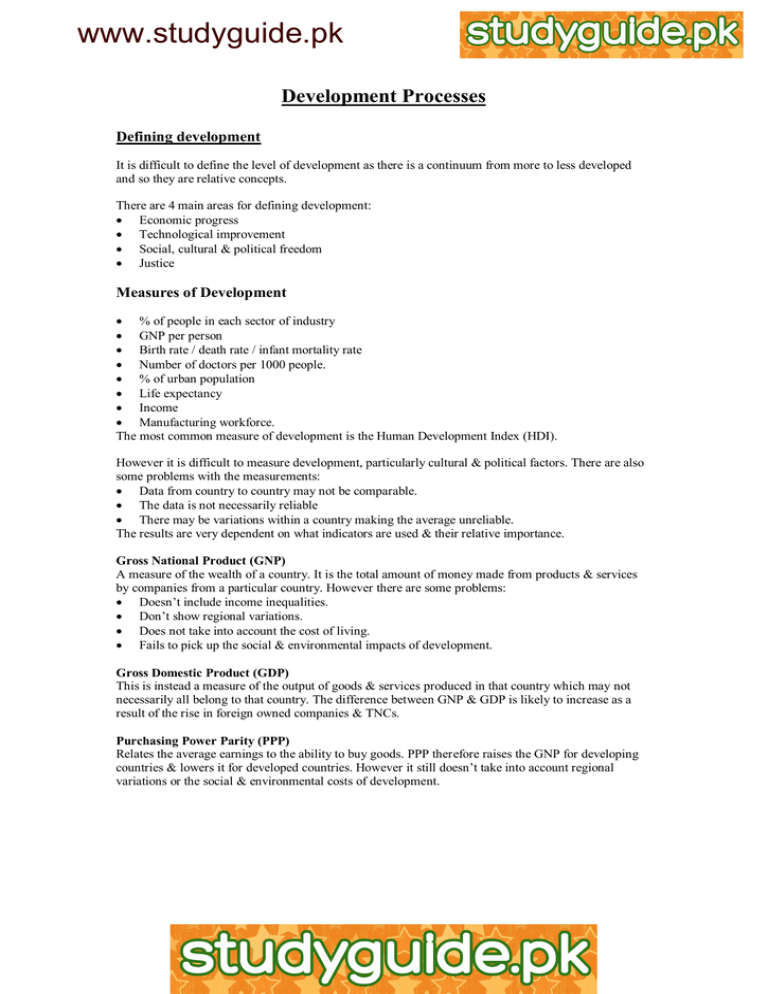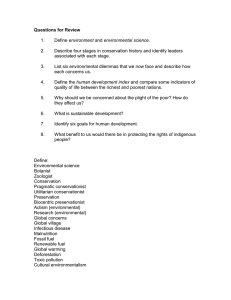www.studyguide.pk Development Processes Defining development
advertisement

www.studyguide.pk Development Processes Defining development It is difficult to define the level of development as there is a continuum from more to less developed and so they are relative concepts. There are 4 main areas for defining development: Economic progress Technological improvement Social, cultural & political freedom Justice Measures of Development % of people in each sector of industry GNP per person Birth rate / death rate / infant mortality rate Number of doctors per 1000 people. % of urban population Life expectancy Income Manufacturing workforce. The most common measure of development is the Human Development Index (HDI). However it is difficult to measure development, particularly cultural & political factors. There are also some problems with the measurements: Data from country to country may not be comparable. The data is not necessarily reliable There may be variations within a country making the average unreliable. The results are very dependent on what indicators are used & their relative importance. Gross National Product (GNP) A measure of the wealth of a country. It is the total amount of money made from products & services by companies from a particular country. However there are some problems: Doesn’t include income inequalities. Don’t show regional variations. Does not take into account the cost of living. Fails to pick up the social & environmental impacts of development. Gross Domestic Product (GDP) This is instead a measure of the output of goods & services produced in that country which may not necessarily all belong to that country. The difference between GNP & GDP is likely to increase as a result of the rise in foreign owned companies & TNCs. Purchasing Power Parity (PPP) Relates the average earnings to the ability to buy goods. PPP therefore raises the GNP for developing countries & lowers it for developed countries. However it still doesn’t take into account regional variations or the social & environmental costs of development. www.studyguide.pk Sustainable Development Sustainable Development Maintaining an overall equilibrium between resource use & resource availability. This is achieved by lifestyle changes, which reduce consumption or use technological efficiency to get more GNP for less resource. “Development which meets the needs of the present without compromising the ability of future generations to meet their own needs.” Sustainable development will depend on: Carrying capacity – The maximum number of individuals of a defined species that a given environment can support over the long term at a reasonable quality of life. Steady state economy – An economy characterised by constant population, capital stocks & rate of material/energy consumption & production such that there is sustainable balance between human activities & the environment. Ecological footprint – The area of land & water required to support a defined economy or population at a specified standard of living. Natural resources – This is environmental goods & services & refers to a stock e.g. forest which produces a flow of goods & services. Environmental debt – The cost of restoring the previous environmental damage as well as the cost of recurrent restoration measures. Inter-generational equity – The principle of fairness between people alive today & future generations so that future generations have the means to achieve a quality of life equal to or better than today's. Intra-generational equity – The principle of equity between different groups of people alive today. China – sustainable development Population: China has a population of 1.15 billion, which is increasing rapidly. There is also rapid urbanisation, which will bring serious problems socially & environmentally with the pressure on the land & the increased demand for food supplies. The ageing population in rural areas does not help this. Rapid economic development: There has been very rapid economic growth of 9% per year but there has been insufficient emphasis on environmental controls. This has led to increased energy consumption creating environmental pollution. The agricultural sector has had to expand to cope with the growing population but this has led to land degradation especially where there is low rainfall, and so desertification & soil erosion occurs. The monsoon climate can bring severe flooding & so exacerbate the problem. The use of fertilisers has caused pollution of water supplies. Overuse of resources There is generally too greater a demand for resources. The demand for water is soaring & demand for wood exceeds supply. Over-fishing for food has led to declining fish stocks. Stocks are beginning to be depleted in coal & minerals due to the excessive use & inefficient processing of goods. Pollution The increased size of cities has led to serious air pollution causing illness in the population. Beijing has 1 of the highest levels of urban pollution in the world. Movement towards sustainable development Huge investment is required to reach sustainable development. Population is now largely under control with the 1 child per family policy. However there are still huge housing problems. There has also been increased spending to help protect the environment & control environmental degradation. There is now a more efficient use of energy with the use of wind power & biogas. Forests have been planted to help reduce soil erosion. There are stricter controls on pollution with stricter regulations & fines for industry. However, urban pollution is still increasing due to the speed of industrial expansion & increased traffic density.





